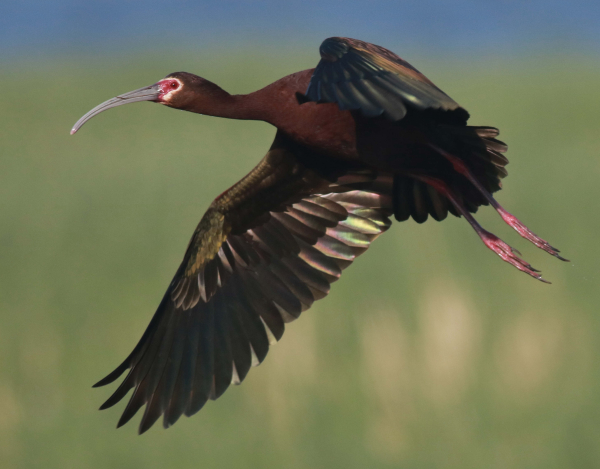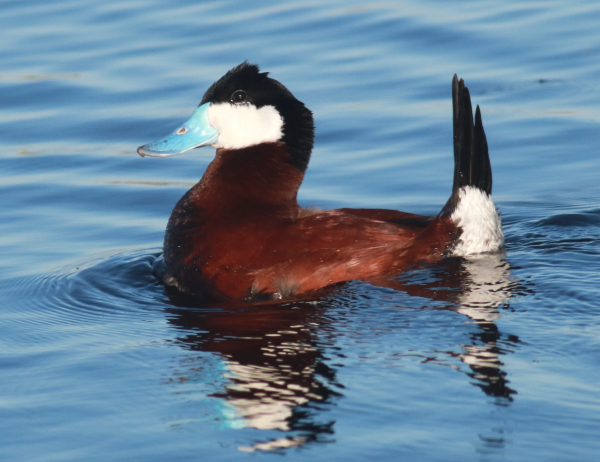 Unusual and beautiful at the same time, White-faced Ibis have been favorite photo subjects during recent visits to McKenzie.  The animated Ruddy Duck drakes have been the most enjoyable birds to observe during recent weeks as they display to potential mates.  A colorful Horned Grebe has provided classic portraits recently while its mate is incubating on a nest out of view, just a few feet behind the territorial male.
|
It was a week of treats! Monday, I was treated to an evening of fascinating Common Nighthawk behavior south of home. Wednesday eve was filled with treats during another bout of action photography at McKenzie, where about 100 White-faced Ibis spread out across the expansive marsh along with plenty of Black Terns, Common Terns, a few Western and Eared Grebes, and lots of ducks and blackbirds. The birds were so active and abundant that it seemed there were a couple, if not a few, photo ops per minute. What fun!
Closer to home, one of the two Great Horned Owl branchers at Melody’s Grove appeared to have taken its first flight: Wednesday morning the young owl was perched in a bare snag150 feet south of the nest tree, and the next morning it was perched near its nestmate on a branch below the nest. That would certainly suggest at least two flights.
I have been seeing, and photographing, a Horned Grebe in a small shallow marsh as it seemed to display for an unseen mate, or potential mate. But finally, Tuesday evening I spied its mate on a nest, barely visible within a curtain of new emergent plant growth behind the male’s usual open water position. That evening I also checked back along the Lost Road, where the night before I witnessed and photographed a flurry of Common Nighthawk behaviors that I haven’t witnessed before or since. I chronicle that interesting episode in this issue’s Bird Photography article, complete with photos – please check it out.
Duck Notes
The first Mallard broods are beginning to emerge, including one brood at McKenzie Slough Wednesday evening. I found two more Mallard broods Friday evening south of my office in the company of one another – numbering 5 and 7 ducklings per brood. The first Mallard brood of the season, a brood of 4 newly hatched ducklings, was present north of home the morning of May 27. Without question, there is a wealth of other hens of a number of species incubating now, with many many more broods to appear.
Indicating the nesting season is in full swing for some ducks, large groups of species-specific “bachelor” groups of Mallards and Northern Shovelers are evident here and there, and smaller groups of male Wood Ducks and Canvasbacks have formed too. There are also plenty of Northern Pintail “bachelors,” but I usually see lone drake pintails or, rarely, two drakes together. Most pairs of late-nesting ducks remain in pairs, such as Blue-winged Teal, Gadwalls, Lesser Scaup, Redheads, American Widgeons, and Ruddy Ducks, but many females will begin egg laying soon. There is an expansive population of ducks in the area surrounding my homestead, including a diversity of species, and I will keep you posted as the nesting season continues.
Feeding Station Surprises
For the past three weeks, I’ve enjoyed having regular visits to my feeding station by two male Baltimore Orioles, one female Baltimore, and one male Orchard Oriole. It appears that one of the male Baltimores feeds exclusively on sugar-water nectar, while the other three orioles feed exclusively on grape jelly. The “nectar oriole” is the first I’ve ever had feed on sugar water, which is actually a plus because there are no hummingbirds here this year – I only ever saw one male Ruby-throat come to the feeder this spring, and he did not feed at the feeder.
To facilitate the oriole’s interest in procuring nectar, I considered adding an oriole nectar feeder to my feeding station. However, because my hummingbird feeder has a good perching rim that circles the feeding ports, I decided I would make my hummingbird feeder a duel feeder for hummingbirds and orioles by enlarging a couple of the feeding ports a bit so the oriole has easier access to the nectar. That has worked well, and I hope after the hummingbird nesting period is over that hummers will re-find my feeder to share it with the big Baltimore Oriole.
Having written the above sentence Thursday, I didn’t have to wait long for a female Ruby-throated Hummingbird to find my feeder – the next afternoon at least one appeared and returned repeatedly for extended drinks. Saturday and thereafter the female or females have been regular visitors. (Indeed, there was more than one hummer in attendance, as I finally sighted two near the feeder at the same time Monday.)
I was also pleasantly surprised to have two new additions to my grape jelly feeder Thursday afternoon – a Gray Catbird, and a male American Robin. By the next afternoon, both birds were regulars, the catbird more often than the robin.
The moral of the story is that birds are unpredictable, and ever moving with ever-changing behaviors, interests, and needs. These variables are certainly among the things that make observing birds so much fun and why they hold our attention day by day, week after week. Enjoy your observations and birding experiences along the way!
Article and photos by Paul Konrad
Share your bird sightings and photos at editorstbw2@gmail.com
